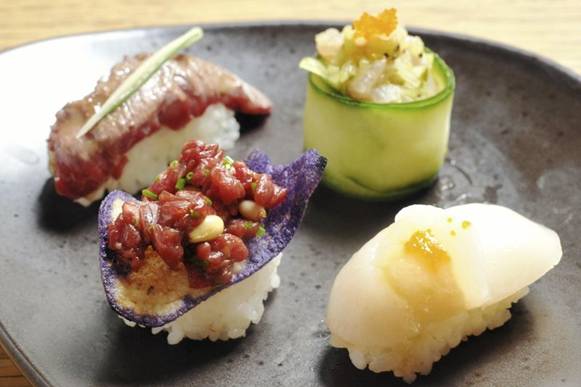Catering to local tastes
Posted on November 15, 2013 On The Japan News by The Yomiuri Shimbun
http://the-japan-news.com/news/article/0000771014

The Yomiuri Shimbun
Tulip boeuf wagyu, front left, created by Chef Thierry Marx,
is among other unique sushi items at Sushi Shop in Paris.
The Yomiuri Shimbun
The popularity of washoku traditional Japanese cuisine—from everyday dishes to expensive kaiseki ryori—has spread to big cities like New York and Paris, influencing their residents’ daily diet. Not only that, washoku is expected to be added to the UNESCO Intangible Cultural Heritage list in December. The Yomiuri Shimbun is reporting on the cuisine through the eyes and palates of non-Japanese. The following is the first installment of a four-part series on washoku.
PARIS—In addition to standard items on sushi menus, such as tekkamaki tuna rolls, French-style sushi dishes are offered at the popular sushi chain store Sushi Shop. “Tulip boeuf wagyu” is one of them. Resting on top of a bite-sized serving of rice lies a crisp sliced potato topped with raw beef. It’s as beautiful as any hors d’oeuvre. The beef is marinated with truffle-flavored miso. The spicy miso sauce matches the fattiness of the beef to create a rich flavor. Tulip boeuf wagyu, priced at €3.5 (about ¥470), is one of the restaurant’s most popular items.
The dish was created by Executive Chef Thierry Marx. Since September last year, he has been working with Sushi Shop to add new dishes to their menu. Marx, who also is an executive chef at a first-class hotel, loves washoku so much that he makes his own miso in the kitchen.
“I have trained at a sushi shop several times during my visits to Japan. I learned how to work with Japanese ingredients during my time there,” he said.
 Sushi Shop serves unique sushi catering to French tastes using ingredients such as foie gras, cheese and mango.
Sushi Shop serves unique sushi catering to French tastes using ingredients such as foie gras, cheese and mango.
“Over the last couple of years, the number of washoku restaurants serving food such as sushi has rapidly increased around the world. We can’t keep attracting customers unless we keep providing new menu items,” Sushi Shop spokesperson Karine Lecomte said. “In addition to Japan’s traditional sushi, we make an effort to come up with original, French-style sushi.”
The Yomiuri Shimbun
Daily foods containing seaweed are sold
at a morning market in Paris.
The company opened in 1998 and has 100 outlets worldwide with branches in the United States and the Middle East in addition to Europe.
According to the Agriculture, Forestry and Fisheries Ministry’s estimate, there are 55,000 washoku restaurants around the world as of March 2013, a significant increase from 24,000 in 2006. The popularity of washoku has introduced a new diet and style of eating to many countries.
In Thailand, for example, shabu shabu restaurants utilize a “sushi train” style system to serve their dish. Each ingredient is put on a plate and carried on a conveyor belt to the customer’s table.
Japanese beef bowl chain Sukiya expanded its operations to Thailand in 2011. To meet local tastes, the company created “Poo Pad Pong beef bowl” for 104 baht (about ¥330). Poo Pad Pong curry, a stir-fried crab-egg curry, is a popular Thai dish.
“The Poo Pad Pong bowl is popular not only among locals but also Japanese tourists in Thailand,” said a Sukiya spokesperson.
Seaweed not just fodder
The popularity of washoku has propelled well-known Japanese ingredients into the international spotlight. Seaweed, for example, was only used as fertilizer in France. But now dishes using wakame and nori, which are made by French producers, can be found at morning markets in Paris.
Minced seaweed marinated in olive oil and seasoned with salt is eaten with baguettes or mixed into pasta by Parisians.
“Thanks to the washoku boom, our company learned that seaweed is a healthy seafood,” a spokesperson of one of the French producers said.
Over the years, washoku developed as Japanese actively adapted cuisines from abroad to suit Japanese tastes. And now, the cuisine is accepted globally and influences cuisines around the world.
Original Article: The Japan Times by Yomiuri Shimbun
http://the-japan-news.com/news/article/0000771014
